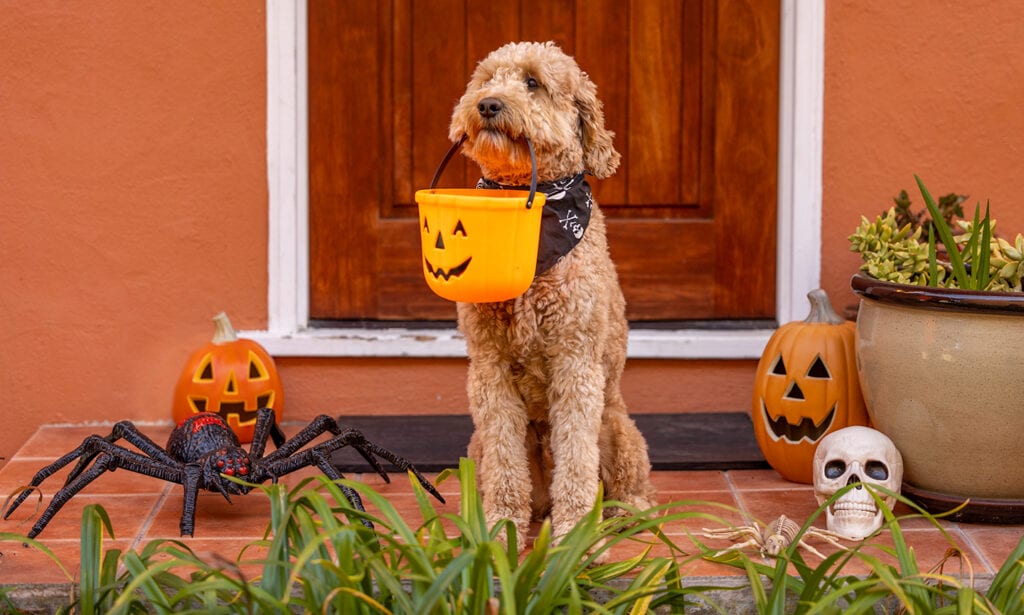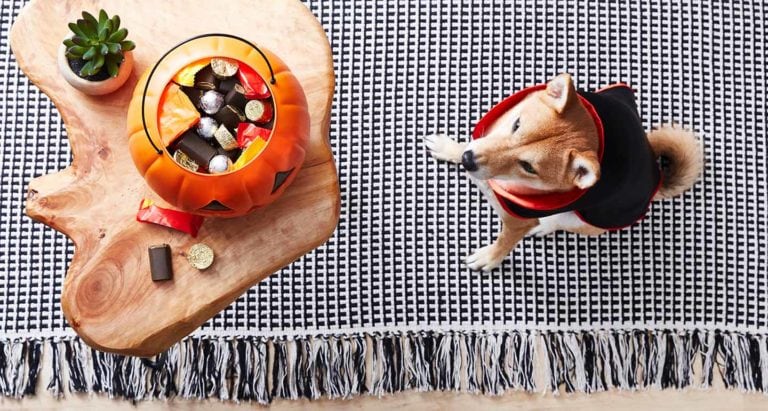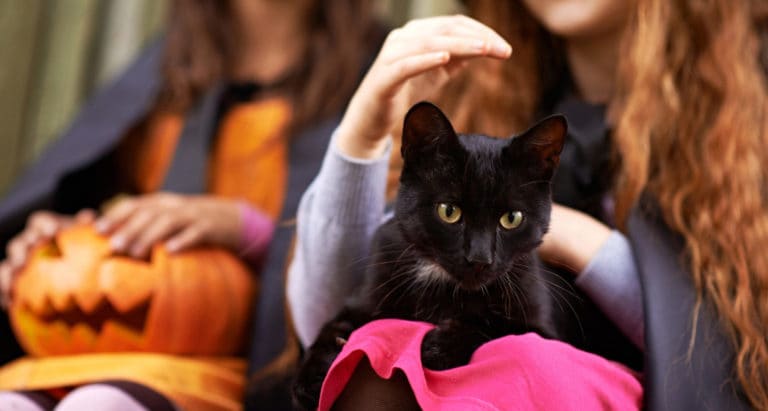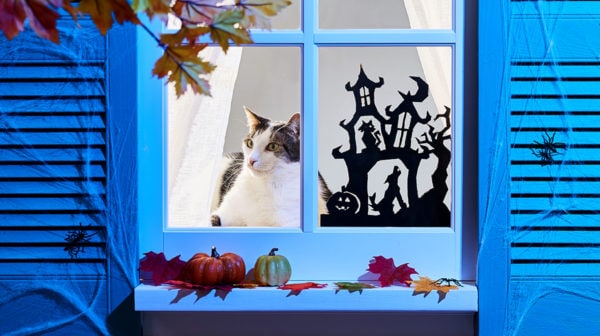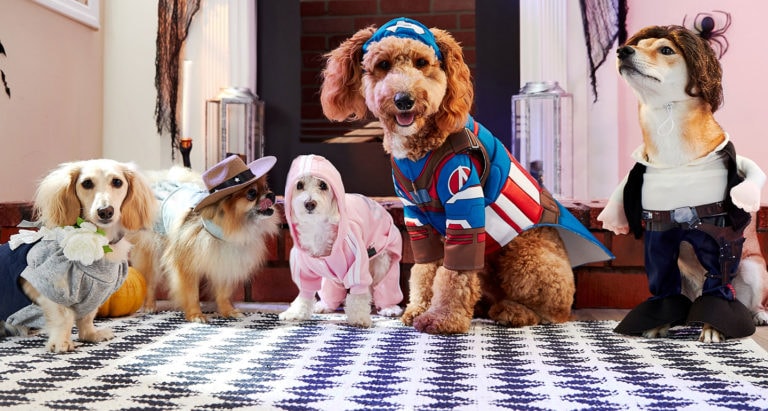Halloween should be full of treats, the occasional trick, and plenty of adorable pet Halloween costumes filling your social media feeds. Unfortunately, it’s also full of potential dangers to our pets, from pet costume snafus and toxic treats to even electrical shock.
That's where these Halloween pet safety tips come in.
With the help of vet experts, we put together a list of ways to keep dogs and cats safe this spooky season, from keeping them out of your candy stash (and especially away from chocolate!) to decorating wisely (no dangling cords!) and more. Following these tips can be the difference between a night of scary, good fun and a night that’s just plain scary.
Bonus: We’ve even included a graphic that you can print and hang on your fridge so everyone in your household will be in the know.
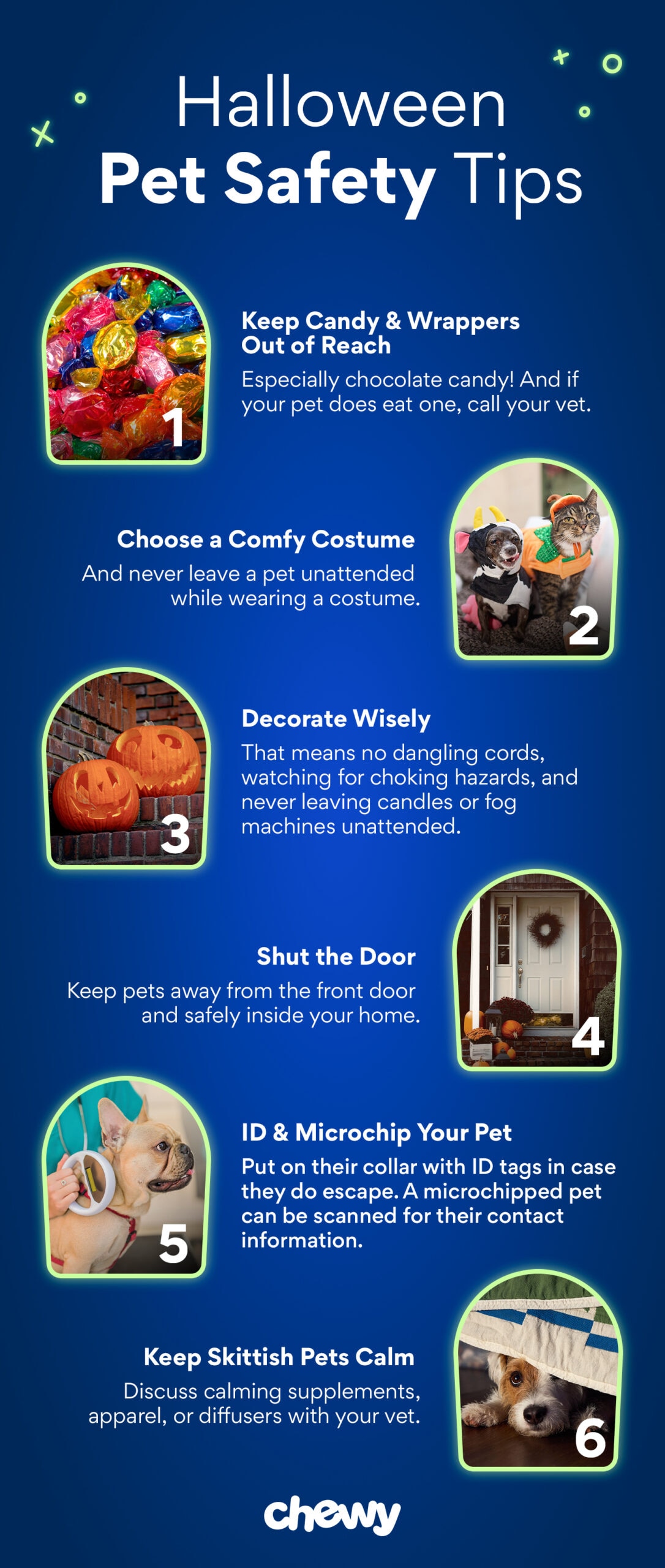
1. Watch Out for Candy Capers
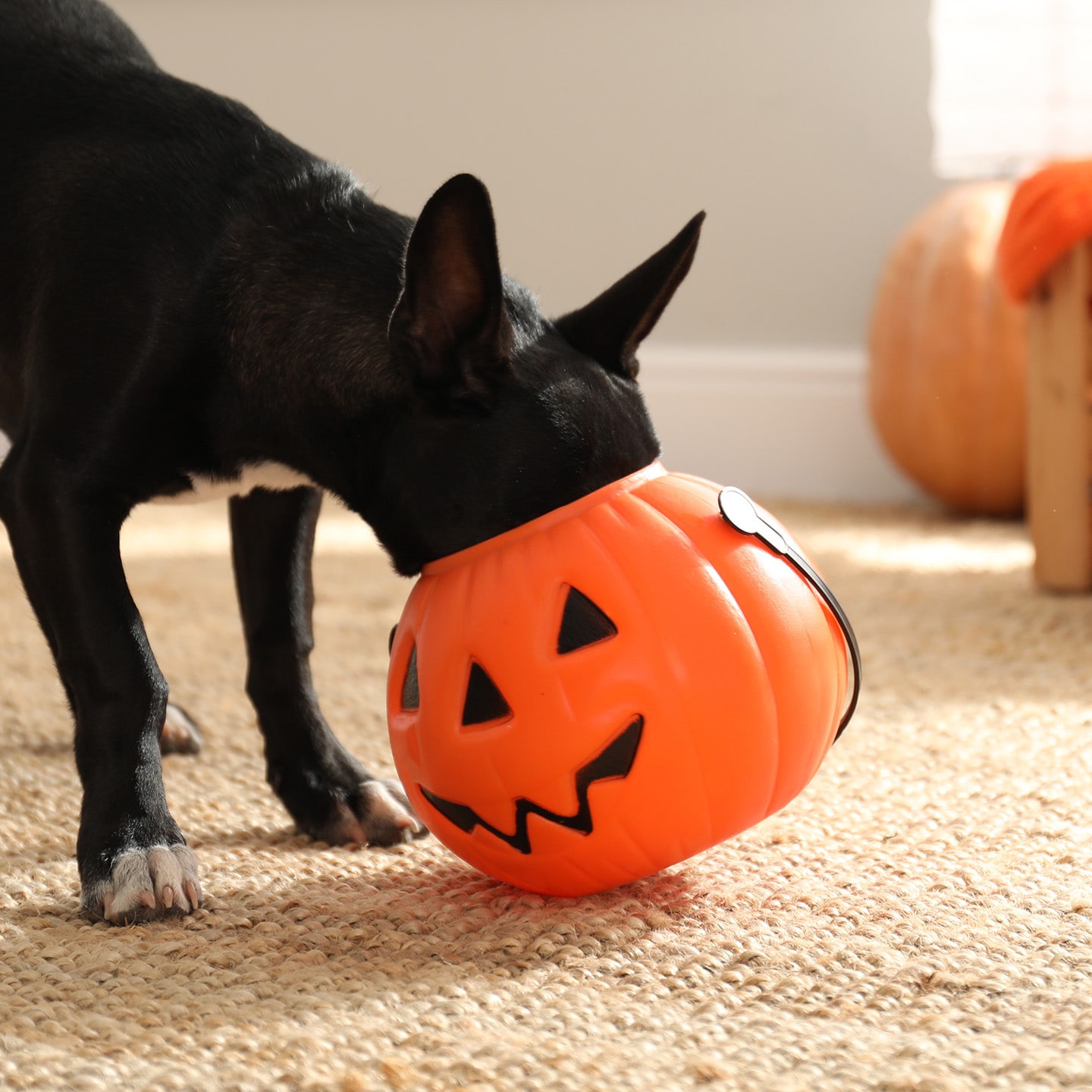
When it comes to Halloween pet safety, keeping all that Halloween candy out of reach of dog and cat counter-surfers is essential. While your pet really shouldn’t be eating any of it, there are some types of Halloween candy that are particularly toxic to pets, including:
- Chocolate: Pet parents might love chocolate, but this sweet treat is poisonous to dogs due to the theobromine found in it, which dogs have a harder time digesting.
- Raisins and chocolate-covered raisins: Raisins can be extremely toxic to dogs and could lead to kidney failure.
- Sugar-free candy: Xylitol is an artificial sweetener found in many foods, including certain sugar-free candies, that’s extremely toxic to dogs and can cause low blood sugar, seizures, liver failure, or death. Xylitol doesn’t, however, cause serious problems in cats, according to the American Society for the Prevention of Cruelty to Animals (ASPCA).
- Caramel apples: First, super-sweet caramel is never a good idea to feed pets. Second, the seeds inside of caramel or candy apples can really make your dog ill as they contain a form of cyanide, says Kiko Bracker, DVM, DACVECC, director of emergency and critical care for MSPCA-Angell Animal Medical Center in Boston, Massachusetts.
- Candy corn: "Signs associated with ingestion of large amounts of sucrose and glucose [found in candy corn] are going to be gastrointestinal," says Leonel Londoño, DVM, DACVECC, clinical assistant professor of emergency and critical care at the University of Florida College of Veterinary Medicine in Gainesville, Florida. "With severe diarrhea and vomiting, signs of dehydration and abdominal pain may also develop, requiring veterinarian attention."
- Macadamia nuts: These nuts are highly toxic to dogs and eating even a small amount can cause weakness, tremors, and lethargy in dogs.
Remember to keep all Halloween candy—including candy wrappers—away from your pet. Consider storing it in a locked or high cabinet that even the most athletic of pets won’t be able to access.
If you suspect your pet has eaten anything toxic, call your vet or the Pet Poison Helpline at (855) 764-7661.
For a pet-friendly Halloween treat, try whipping up DIY peanut butter cup dog treats so your pup can join in on the fun!
2. Choose a Comfy Costume

There are so many gosh-darn cute costumes out there for pets of all kinds, from large pups to guinea pigs. But while there may be, in theory, a costume for every pet, not every pet wants to dress up—and that’s OK! It’s important that all pets feel comfortable.
Follow these tips when dressing up your pet for Halloween:
- Choose a comfortable costume that fits properly, doesn’t restrict movement, and doesn’t hinder your pet’s ability to breathe. (Pay special attention to those Chewy size guides.)
- Take off the costume if your pet displays any signs of stress or discomfort, which can include pacing, hiding, or refusing to move, according to Bethany Howe-Fanning, DVM, CVA, of Hawkins Animal Hospital and Wellness Center in Ronkonkoma, New York. (No cute photo op is worth your pet’s discomfort.)
- Check the costume before the big night to make sure there are no loose buttons or embellishments that your pet could tear off and swallow.
- Ensure their Halloween fashion show is brief. Your pet might be game for a quick Instagram photo session in their costume, but they may become uncomfortable if left in their outfit for a longer time.
- Never leave your pet alone when they’re dressed in their costume. You need to keep an eye on them in case of a costume malfunction, like if their costume gets caught on something.
3. Beware of Decoration Dangers
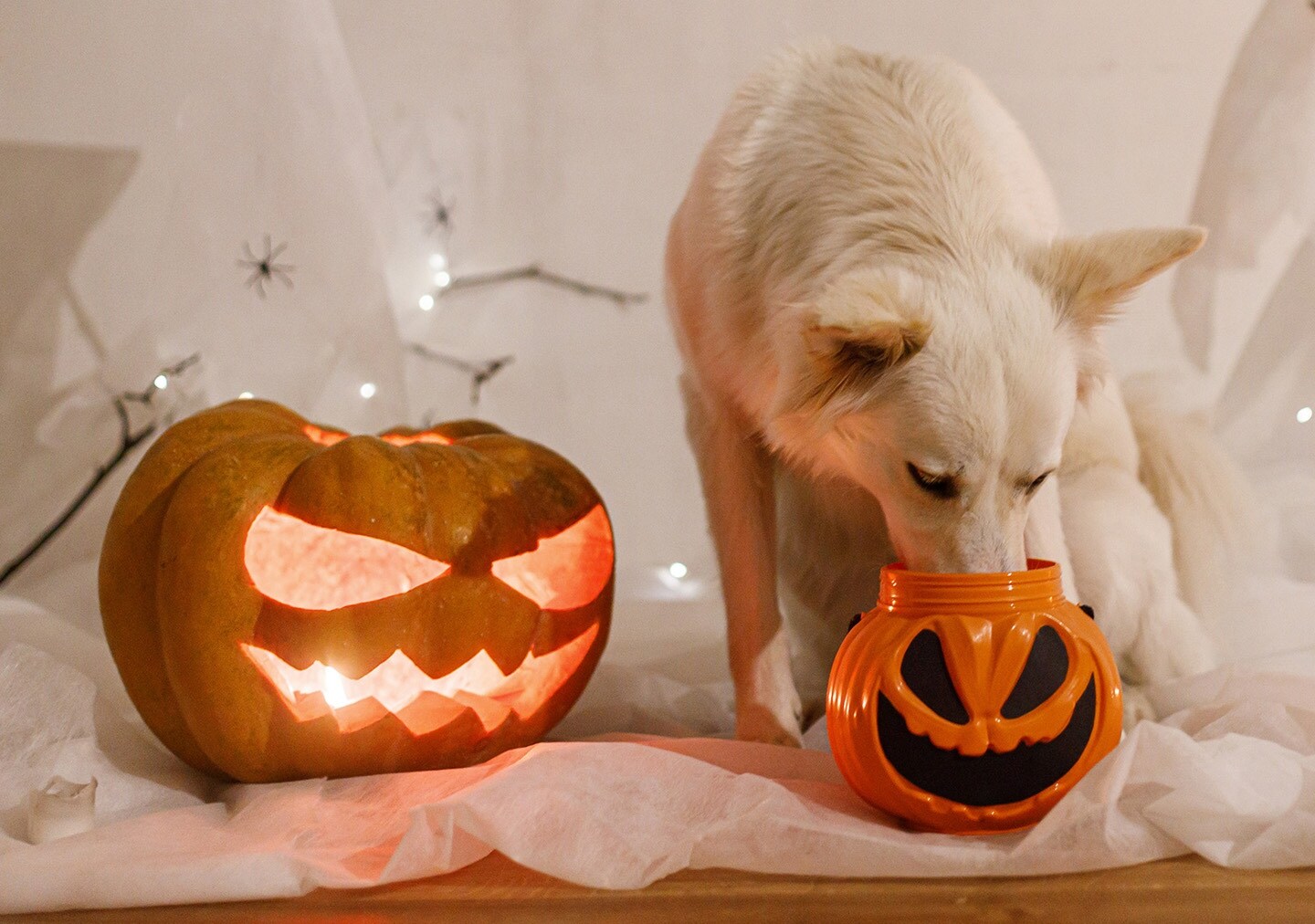
Some Halloween decorations can also pose a Halloween pet safety risk, such as:
- Electrical cords: Pets can easily chew on them and get an electric shock or get tangled up. Opt for decorations that run on batteries, rather than electrical cords.
- Fog machines: You don’t want them to consume the possibly toxic solution. Keep these away from pets or pass on them, period.
- Glow sticks: Some pets may mistake these for chew toys. Like fog machines, you don’t want them to consume the possibly toxic solution. While the liquid inside the glow sticks is nontoxic and won’t make pets sick, it tastes awful. And according to the ASPCA, pets who bite into glow sticks may begin drooling and running around the house.
- Candles: Lit candles on their own or in jack-o'-lanterns are seasonal favorites, but boy are they fire hazards. Dogs and cats can easily knock them over or burn themselves. So, opt for faux candles or keep them in an area out of pet’s reach.
- Small decorations or decorations with small baubles: These can be a choking hazard. Skip these types of decorations.
4. Keep Them Away From All the Hocus Pocus
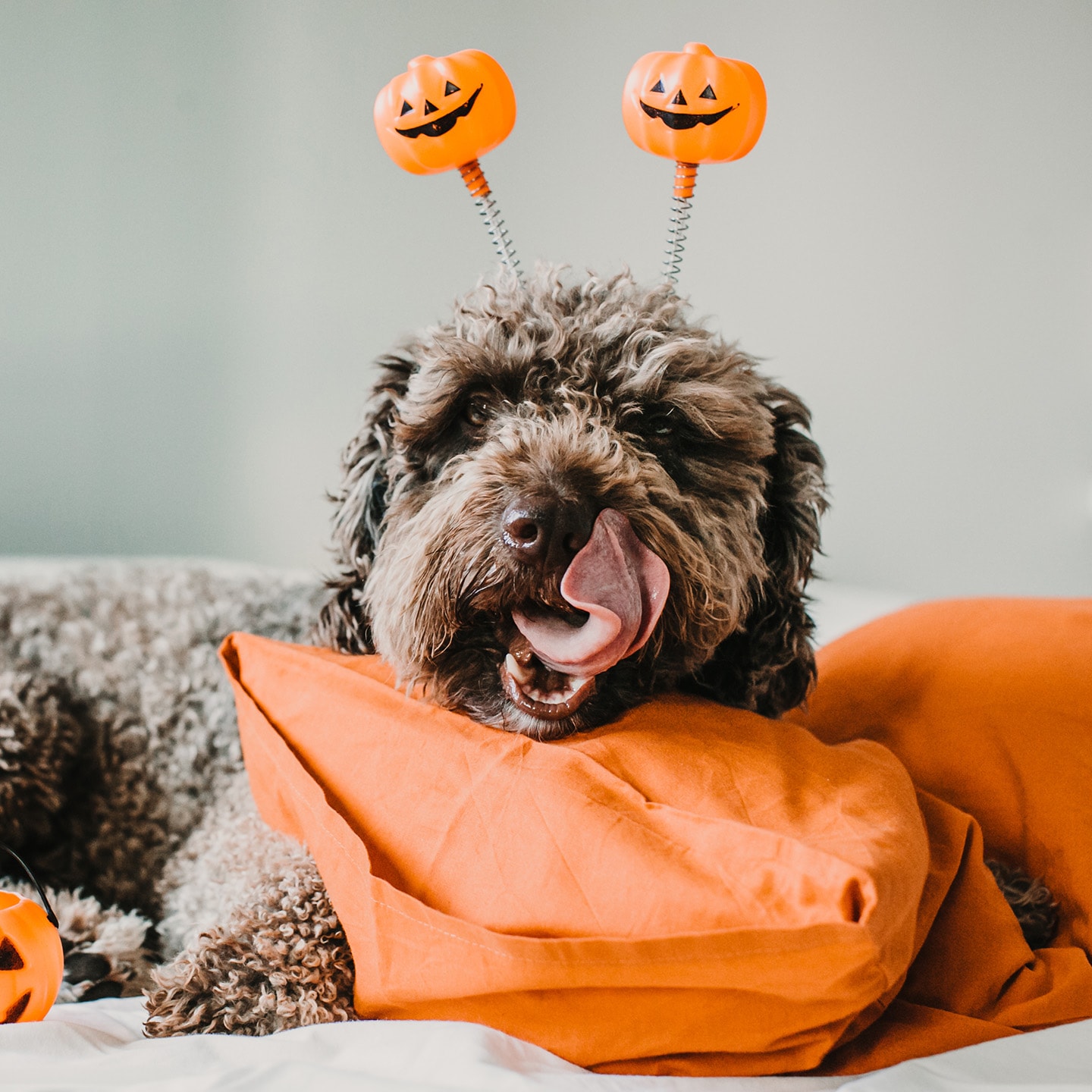
Can you think of anything scarier than one of your pets getting loose? No spooky story or horror movie can compare to that scary scenario!
To prevent your pet from slipping out of the house, follow these tips:
- Keep pets away from the door. With the front door opening and closing so often on Halloween night, it’s best to keep pets away from the door and all the action to prevent them from slipping out, leaving you with a lost pet.
- Keep your pets safely crated. During trick-or-treating hours or if you’re having friends over for a Halloween get-together, the best course of action is to keep your pets safely crated and out-of-sight of the front door, advises Dr. Howe-Fanning.
- Or keep them in a secure, quiet room. Be sure you add some creature comforts to their secured space such as their bed, water, food, your cat’s litter box, and a favorite toy.
5. Tag Your Tiny Trick-or-Treater
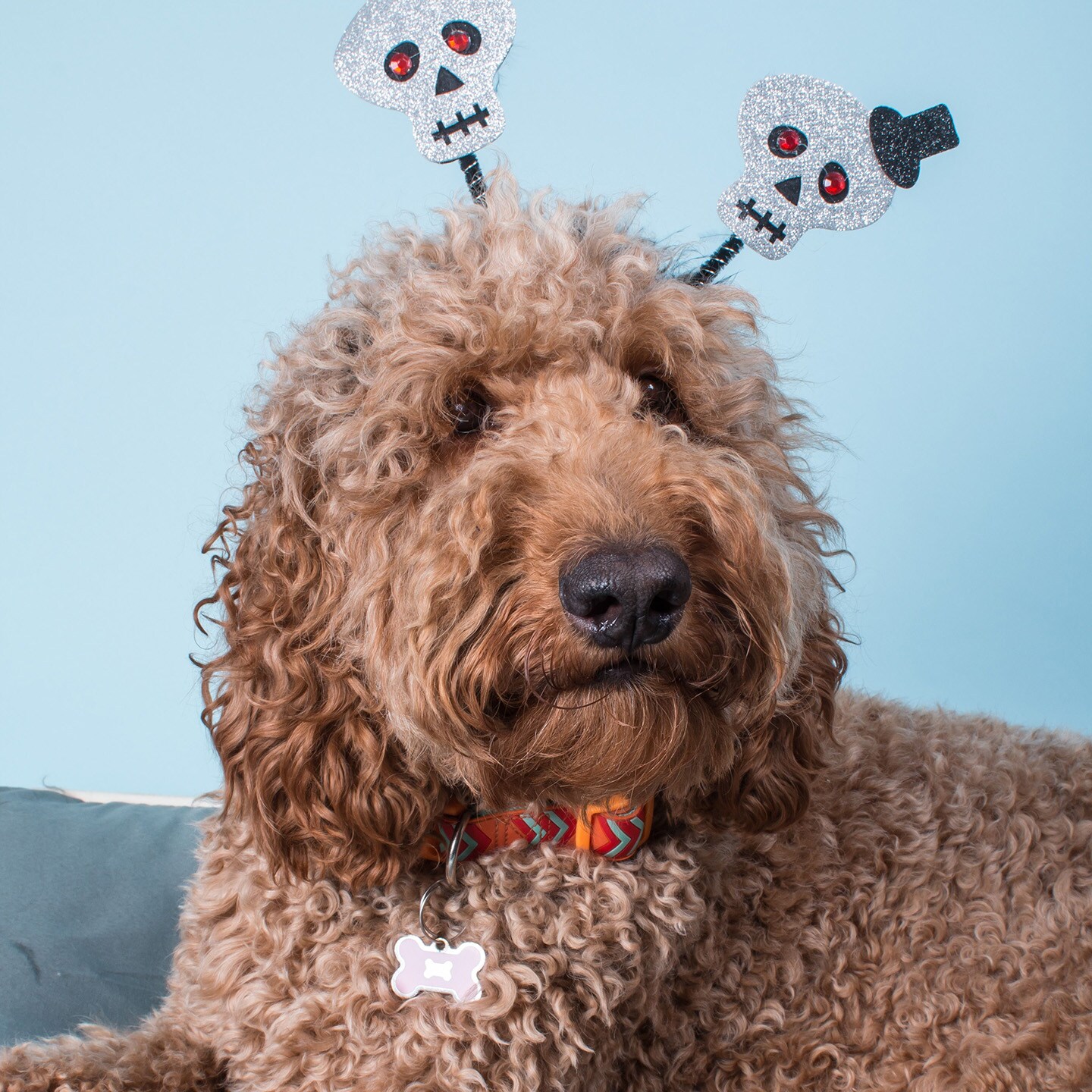
Should your pet slip out of the house, proper identification can help get them home safe and sound—and quickly too.
Double check that their collar and ID tag are all secure and up to date.
If your pet is microchipped, ensure that your contact information is correct in the microchip company’s database. If your pet isn’t already microchipped, talk to your vet about the simple procedure to provide future peace of mind.
6. Help Keep Them Calm

Prepare for a rise in neighborhood activity—and the anxiety it may bring your beloved animals. Trick-or-treaters ringing the doorbell throughout the night, encountering people in costumes during your evening walk, and scary sound machines set up outside houses can stir up stress in pets.
Watch for signs of stress and anxiety in cats and dogs, including:
- Panting
- Hiding
- Excessive vocalization
- Pacing
- Going to the bathroom in the house (or, for cats, outside of the litter box)
If you notice any of these signs, contact your vet to rule out any medical problems and, if none exist, consider a calming supplement or calming apparel to help ease their symptoms on potentially stressful days, such as Halloween night.
Calming Supplements
Vibeful™ Calming Soft Chews for dogs, for example, feature a combination of ingredients—like melatonin, passionflower, chamomile, and valerian root—that together can help relax pups. Just be sure to talk to your vet before giving your pet any new supplements.
Calming Diffusers
Calming diffusers such as the Adaptil™ diffuser for dogs and Feliway® diffuser for cats are another option to consider. These diffusers are made to release special dog- and cat-appeasing pheromones to help pets feel safe and secure.
Calming Apparel
ThunderShirt® is designed to hug your pet with gentle, constant pressure to potentially calm fear and anxiety. There are versions for both dogs and cats, so all your furry family members can reap the benefits.
While caring for your pet on Halloween can present challenges, following these tips can ensure everyone in your family stays safe and has a happy Halloween. Next, let's look at the best Halloween costumes for dogs and cats.
Expert input provided by Kiko Bracker, DVM, DACVECC, director of emergency and critical care for MSPCA-Angell Animal Medical Center in Boston, Massachusetts; Leonel Londoño, DVM, DACVECC, clinical assistant professor of emergency and critical care at the University of Florida College of Veterinary Medicine in Gainesville, Florida; Bethany Howe-Fanning, DVM, CVA, of Hawkins Animal Hospital and Wellness Center in Ronkonkoma, New York; and Jennifer Coates, DVM, a veterinary consultant in Fort Collins, Colorado.
This content was medically reviewed by Chewy vets.
More Ways to Have a Fun and Safe Halloween with Your Pet:
Share:
